#so i went to see the doctor at our local weekend and holidays public health clinic
Explore tagged Tumblr posts
Text
.
#so i had acute tracheitis like two weeks ago#then at the follow-up visit the doctor said i was ok#so i went to malta for my vacation without worrying about the occasional cough that eventually stopped#but then at the end of the trip i suddenly had temperature 39°C#i got better and went back to poland#i got home yesterday but suddenly today my voice is gone#and i started coughing again#so i went to see the doctor at our local weekend and holidays public health clinic#and it turns out i have acute tracheitis (again)#AND i also have acute laryngitis (new)#i had a doctor's leave before my vacation and now i have a doctor's leave again krehxksjkx my boss will be upset but oh well#i'm on antibiotics again 🤧#anywayyyyyyyyy why am i sick again the doctor said i was fine the last time 😞😞😞 WELL#anyway i felt totally fine for 8 out of 10 days there so i'd say the trip was still ABSOLUTELY AMAZING#absolutely amazingggg guys i loved it so much#i'm so glad the sickness came back only at the very end when i had already seen and done almost all i planned so it was okay#it was so wonderfullll i need to show my army followers here some pictures later on because oh man are they crazy#okay rant over i'm going to go lie down#maybe watch a bit of bon voyage on malta lmao it's so fun to watch it now that i've been there myself#my post#personal
9 notes
·
View notes
Text
H.E.A.L.T.H. What is it?
For many years, ive been trying to get all these beautiful inspiring stories out of my head and out into the public. I believe that I have a message and maybe my delivery is off but its there.... There is no right or wrong way to deliver a message because it truly comes down to the perception of the receiver, not you that creates the problem. If you have a message to share with the world.. share it, and if the world isn't ready, thats there issue, not yours. So here’s mine.... well a small piece of it...
Have you ever thought about what the true definition of health is? Is the worlds definition of health congruent with your own definition? How did you come to your own way of health or do you follow others and envision yourself as them maybe when you were completely out of balance with yourself. Or did you do research on ways to quick fix your health Hit?
There are so many ways we can view health and in each one of us, its different. Take a smoker of 30 years..... If you or someone you know has smoked for a very long time and are thinking about quitting, you know its gonna be stressful. Even if you are 100% committed to giving up the filthy habit and saying good rides, the body and mind are going to, at some point be in stress overload. The nasty chemical of nicotine has adapted inside your body and your cells feed off of them but then ll of a sudden, you are suffocating the fuel for which stimulated the craving when they were on empty... So your brain thinks, “feed me nicotine, feed me oral fixation.”
No patch, gum or physical ailment has ever been the true reason some someone killing the habit. The real healing and transformation comes from the energetic balance between what our mind is telling our body, and what forces surround us in our environment the controls our cravings within our body.
For 12 years, I smoked very heavy cigarettes. Not the Light to Ultra light brands but the stuff the big boys, construction workers, mechanics, Beer Bellied red necks, used to smoke. My mom allowed me to smoke as many cigarettes as I wanted, just as long as I only smoked cigarettes and nothing else.
In June 1999, after a car accident nearly caused my death, I was awaked into a new light and mindset. Still smoking cigarettes, going to church and attending local exercise classes, my perception to things was different.
After 4.3 drooling months of battling a disconnect of me headspace and my Mind Body Spirit connection being in OFF mode, I was turn on with more voltage and internal power than ever before.
In October 1999, 2.5 weeks after I was forced to drop out of high school, I was blown away that something so big, and active was living inside of my head. I asked myself, how could this tumor, be so unkind to just appear out of the blue and say, “That’s it Lady, POWER OFF.”
I was a senior in High School, passionate about hospitality, working for Marriott hotels 23-28 hours a week in front office operations and selling shoes at Nine West 13-17 hours/week M-F. Marriot was a Fri-Sat-Sunday job with Holidays for the additional overtime. After my accident, I lost my job at the shoe store however Marriott loved my positive energy and life force I expelled to guests while they checked in, even when I couldn't see over the front Desk front sitting in a chair from Pain. Although I felt much loved at this hotel, I would soon be discharged from here as well.
October 24th, 1999, after my first attempt to get my GED, the equivalent to a High School Diploma, I failed. I felt horrible with my life. I had no job because of my disability, I quit high school and barely saw my friends, no driver license because they were taking from me by the State of Ohio for safety of other drivers and I was smoking 2-3 packs of cigarettes a day. How was I able to come out of this mess and go from SURVIVING to THRIVING? It certainly wasnt some Miracle pill or Reconstructive Surgery that changed me from the outside to inspire my inside...... It came from within me! How I looked at the physical things around me, how I gave thanks to everything, even a bird dropping its poo poo on my head while trying to sunbathe next to my neighbors pool, or having a check for $3.84 bounce over a pack of cigarettes. What taught me the greatest life comeback in these scenarios.
It was a wet and muggy Wednesday morning in October, the 27th to be exact, when my mom dreaded waking at 745am to take me to get a second opinion from a doctor at the Cleveland Clinic office near my small hometown. She had finished work at 1130pm the previous night to only arrive home around 1215am from the heavy rain that evening. My first appointment was at 830am.
There were actually several appointments scheduled that day however my mom had to be at work by 1pm and wasnt able to take me to all of my appointments. After the first appointment, we decided to skip the potential MRI and take me to grandma’s house.
For the next 9 months, until June, the summer of 2000, I stayed with grandma. It was a much happier place to be. Grandma had 3 fun loving dogs, a pool with a beautiful wooden deck big enough for 5-7 lawn chairs, and my aunt Kathy living within walking distance. Kathy smoked and she was more like a smoking buddy. I was able to make some money mowing yards for the neighbors and helping grandma with the house and her dogs. In June, I got my driver license back and went on a mission to find a job that would give me independence away from everyone! It was the greatest stepping stone into womanhood I could've ever taken.
After attempting to retrieve my job with Marriott and being unsuccessful, an amusement park on the lake outside of cleveland contacted me for a summer job at one of their hotels in the park. Cedar Point is the PRIME ROLLERCOASTER park in the USA. Without hesitation, I took the job and moved 2.5 hours away in a cabin villa with 2 other girls, for the summer.
Cutting to the chase... at the end of the summer, I felt like i was ready to go back to school and try my HSD again. It didnt take long to see that, this wasnt supposed to be the option for me.
August 2000, just days before school was to begin, mom and I, her friend Cheryl and our long time neighbor were shopping for school supplies at our local Staples Store. Cheryl had MS and I took care of her also. Without her with us, my mom would've been in the Emergency room.
As we were walking out of the store, I started to dauntingly walk a different direction than my mom and Cheryl. Completely disconnect from the world, my mom said she continued to yell at me but I didn't listen. Was I not listening or did I not hear her?
In the moment when my mom gently grabbed my right shoulder to bring me toward our truck, I physically attacked her, bruised her face and she fell on the ground. Immediately she got back up and “started calling me names”, Cheryl said. Before we got to the truck, I came out of this brain freeze and began to ask my mom “Oh My God, what happened to you?”
You can imagine my mom’s confusion, frustration and contemplation as to why I seemed to disillusioned to the event. This object in my brain was moving again and this time caused a disconnect that changed my life traumatically, with myself and my mother.
A week before my Mom’s birthday, September 4, school had only jut begun and I was doing good until the long 3 days weekend for Labor Day. Labor day is the 1st Monday in September and my mom’s birthday happened to fall on that day however our doctors office was closed.
The very next day, with a luck of the draw, Dr Angerman, who I saw the previous years, had a slot open at 9am which my mom booked me without question. The findings were what had been daunting me for more than 15 months.
Ganglioglioma is low-grade tumor of mixed cell type. It is a type of brain tumor that contains properties of both glial cells (responsible for providing the structural support of the central nervous system) and neuronal cells (the functioning component of the central nervous system). It is very rare!! Being rare was one thing but with the location being life threatening inoperable, my mom burst into tears with fears of what to do with me.
My Ganglioglioma treatments included: Neurosurgery – to remove as much of the tumor as safely possible; surgery is often limited due to the deep, central placement of these tumors within the brain Chemotherapy – either before surgery to shrink the tumor or to kill cancer cells
Radiation therapy – precisely targeted treatment to control local growth of tumors; not recommended unless the child’s tumor has re-grown due to potential long-term side effects of therapy.
Cleveland Clinic has some of the most highly acclaimed doctors and surgeons in the world. They are one of the best trusted hospital resources for Neurological, Cardiac and Pulmonary operations. With a higher success rate than any other hospital affiliation on the entire planet, Dr Angerman relaxed my mom and assured her that I was in heaven’s hands. On March 12th, 2001, I became a successful survivor of this rare scare of a brain tumor however the end wasn’t close yet.
After 3 days, I was released from Cleveland Clinic Neurosurgery in Cleveland, Ohio, with 100% full confidence by Neurosurgeon Dr. Morris, that I would recover with no problems. March 16th, while at my grandmothers house, I had a stroke. I was paralyzed on the entire left side of my body for 6 weeks until April 29th 2001......
Dr Morris did an amazing job at my surgery and was the first person and step that gave me internal hope that led to my wellness path to what I call HEALTH however, it was the energy practices of Yoga& Pranayama, which no one in my red neck town had ever heard of), Mindfulness, Chiropractic, proper nutrition and guided imagery that allowed me to transform my mind, come back in tune with my body and provide positive feedback that would change my life, inside and out, forever.
It’s now 18.5 years later, Aug 2019, and my passion for helping people, inspiring wellness and Mind Body Medicine to everyone I meet, especially as a career, gains excitement everyday! My true meaning of HEALTH is Holistic Enhancements Aspiring Longevity Tranquility & Happiness. Because true health starts with me, not with money, a beautiful BMW, fancy vacations or diamonds... It starts at the HEART... tap deep within and you will win.... no matter what you are going through!
When we live life in a state of our own positive definition of HEALTH, whatever it may be, we are creating an art that is unique to us and us only, but its from the heart. Learn to BREATHE... and used the same formula components(letters) to BE HEART!
Sorry for any typos...
Namaste, Good Night friends.
#health#wellness#mindbodyconnection#thepowerofhealing#overcomingobstacles#lifechangingmoments#energymedicine#yogainspiration#iloveyoga#breathe#beaninspiration#survivingtothriving#cleveland clinic
2 notes
·
View notes
Text
December Recap
(+ A typical Estonian Christmas dinner table!)
Merry Christmas, dear followers! I hope you've all enjoyed the holidays, cause I sure have and I'm gonna summarize my entire December month right here (since I've been rather quiet these past few weeks, but that's only because I was so busy doing all of these wonderful things).
First and foremost, I wanna introduce you to some Estonian food that's usually eaten during Christmas (yes, it's okay to reblog this post cause the personal stuff will be under the cut). I took a few photos of all of these delicious meals and am gonna describe what they are exactly. Here is my family's dinner table in its full glory:

So, where do I start?.. The 3 bigger pots on the left contain boiled potatoes, small sausages ('sardellid' in Estonian) and sauerkraut (a type of cabbage, the English name of this food should have a German origin). These combine into one dish and they're eaten together, like this:

The 4th, bigger glass plate on the right contains blood sausages, which is the second typical dish (the kind that we buy come with slices of bacon). They're usually eaten together with lingonberry jam or pumpkin slices (my dad prefers to add some mustard), BUT.. ever since I was a little girl, I've had this quirk of adding ketchup to any kind of meat to make it tastier. So, when I began eating blood sausages, I obviously chose ketchup on the side:

Besides that, Estonians LOVE black bread (note the bag in the background), which is made of rye and completely different from any other kind of bread everywhere. This is where a really good joke about my people comes from: whenever Estonians travel to another country, they can't find their "usual" bread in any grocery store (it's all white!) and it's one of the things they'll miss the most while being away from their homeland:

Now (coming to the foreground), I am in NO way trying to advocate drinking (since I'm a teetotaller myself), but for those of you who are interested in trying a unique brand of alcohol from Estonia, then you should definitely buy a bottle of "Vana Tallinn" ("Old Tallinn").
Since both Estonia and Latvia celebrated their centennials this year, I watched a documentary about the latter's history in November (Latvia's Independence Day is on the 18th). They mentioned the "Riia palsam" ("Riga Balsam") there, which reminded me that I've never tasted our very own "Old Tallinn" before, so I wanted to give it a shot.
It's a liqueur and this was my first time drinking it - I didn't like it (exactly like all the other times when I've taken sips from different kinds of alcohol, I don't think I've tasted wine yet though..). The smell reminded me of that disinfecting liquid that doctors would use to clean wounds. I preferred that box of non-alcoholic glogg on the right more than "Old Tallinn", ha-ha!
I think that's about it for what I wanted to say about our food, now onto more personal stuff. I didn't mention any desserts (since there isn't anything unique), but in our family, we like to buy premade gingerbread cookies from the store (not enough time to bake any of our own) and decorate them with colourful frosting (it's still fun!).
You can guess which ones are made by me or my mom (hint: all of the ones in the first photo + I wrote the characters' names from both Avatar series and Voltron + drew some pretty winter-related items/patterns + the little map of Europe and Estonia in the bottom right corner of the last photo):



Besides that, I like to buy an advent calendar filled with little chocolates for the first 25 days of December. Just like last year, I bought a "PAW Patrol"-themed one this year. And on a trip to our capital Tallinn, I finally managed to buy the third pup plush I was missing - Marshall! (I already bought Chase and Skye back in May.)

Speaking of that trip to Tallinn, then I went there together with my dad since we'd bought tickets for the big finale of the 7th (golden) season of "Su nägu kõlab tuttavalt" (which might've been the last, but nobody knows for sure, not until next autumn).
It's a show (the finale was live on TV) where 4 men and 4 women (who are our own local, famous actors/singers) parody or try to mimic an artist/band and one of their songs as well as they can (and they work really hard on tweaking their performances to look amazing + the team behind the cameras and in the make-up/dress room, the back-up dancers and mentors Maiken and Villiko contribute just as much).
There are 8 pre-recorded shows shown each weekend on Sunday, which lead up to the big finale. In each of these shows, the 4 judges give the participants points for their performances, based on how well/accurately they did. The one who receives the most points wins that night and gets to donate 1,000 € for charity (they pick an organization that they'd like to help).
The 4 participants with the highest scores by the end of those 8 pre-recorded shows will be the finalists in the finale (the other 4 will perform, too), where only the audience can vote for them via telephone. Ultimately, their votes will choose the winner of the season, who gets to donate 10,000 € for charity.

This year, the winner was Saara Kadak (on the left, with the show's host, Märt Avandi, on the right). She mimicked ABBA's "The Winner Takes It All" (my mom's favourite band) and did it ever so beautifully (in my opinion, she deserved to win)!

A day after the finale, a lottery-type of competition was held on Facebook. I entered and, for the first time ever in my life, I actually won something! A poster of Saara Kadak (with her golden signature on it) and the cheerleaders of TalTech (my old university, previously known as TUT or TTÜ in Estonian), where she was dressed up as Toni Basil and together they parodied the song "Hey Mickey" in one of the pre-recorded shows (it was awesome!):

Since we're still on the topic of concerts, then I'd like to mention that I also went to a special Christmas concert (which was part of a bigger tour) at our local church, where Koit Toome and Valter Soosalu sang some lovely holiday-themed songs. I enjoyed it very much, exactly like last year when I went to Elina Born and Stig Rästa's concert. (I think this is going to be a new tradition for me, to go to at least 1 Christmas concert before the holidays.)
After that concert, me and my dad drove to a small town called Väätsa to go have a look at their cultural center. That little place has become famous for organizing weird (but in a good way), yet fun events. This winter, the locals had decorated all the windows of the building with pretty installations/decorations, some of which moved around thanks to their mechanisms/reacted when someone walked by (such as these two coffee mugs, where the coffee started to pour down from top to bottom when my dad passed the window):
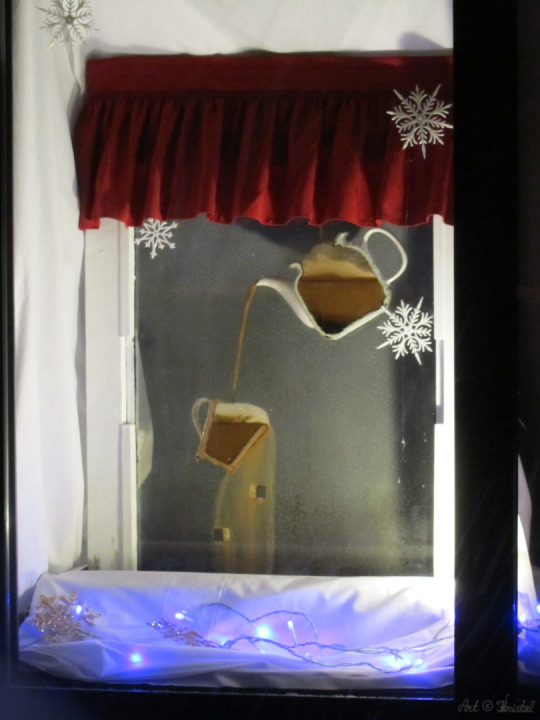
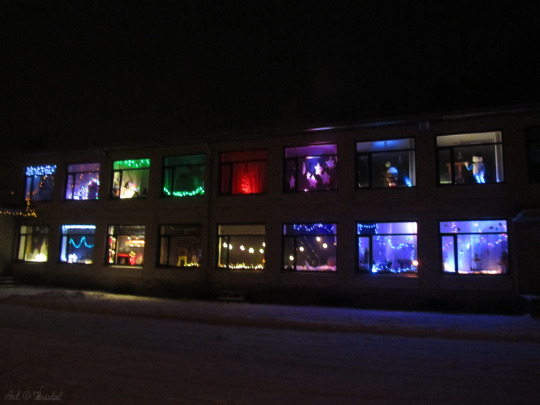



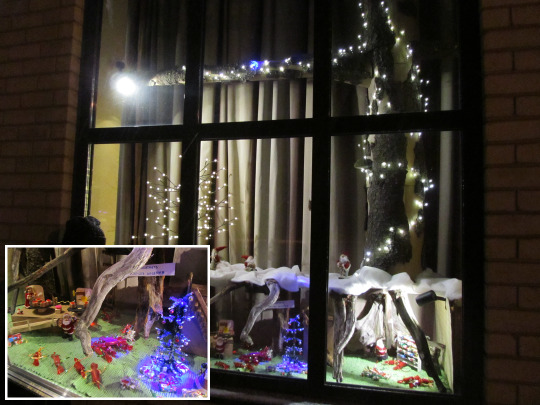
On our trip to Tallinn (the same day I bought Marshall and we went to the finale of SNKT), my dad and I wanted to visit the annual Christmas market in the Old Town (it's up from the middle of November until the beginning of January). Did you know that it was chosen as the best one in Europe this year? If you happen to visit Estonia next year, why not pop by and have a look for yourself (that's the old Town Hall in the background):

Finally, here's a glimpse of our Christmas tree and the presents I received this year (I checked this Monday and my preordered copy of "Imbalance: Part One" was shipped on the 18th and it should arrive at the beginning of 2019, yay!):


Most importantly, seeing just how much truth has suddenly become public about how weak our healthcare system is when it comes to people with rare diseases/who need their medications financed by the health insurance fund (and how stingy the council can be when making these decisions) and how our own country charges 9% off from all donations made to the Cancer Treatment Fund, I decided to help out by donating 15 € to 3 different charity shows this year:
Donated 5€ to "Jõulutunnel", which raised money to donate to the Children's Fund of the Clinic of Tartu University for helping kids with rare diseases this year.
Donated 5 € to "Jõulusoojus", which raised money so they could buy the physically-impaired children a robot that'd help them learn how to walk (again).
Donated 5€ to "Inglite aeg", which raised money to help specific people who sent them their stories, people who usually don't have enough money to pay for an expensive treatment or cure and can't live a normal life or who are suffering in a different way (such as losing their home to a fire).
*wipes beads of sweat off her forehead* Phew! Writing this post took me like.. 2+ hours! Anyways, I hope you've enjoyed reading about how December went by for me. Thanks for sticking around!
5 notes
·
View notes
Text
January 2017
On January 1st my friend Alvaro and I checked out of our AirBnB, grabbed lunch, then hopped on the bus back to Guatemala City. It is pretty common for bus drivers to charge up to 3x the normal fare on holidays. I always thought this was something normal and legal that they could do, but as we entered Guatemala City a policeman got on the bus and asked all of us how much we had paid because apparently bus drivers aren’t allowed to raise prices. In our case he hadn’t raised it much, but the police made him pay us all back the excess that he had charged us. Late that night we met up with Alvaro’s Peruvian friend, Yessi, to get dinner.
One of my good friends, Steffi, works as a volunteer for a soccer team that is just starting by doing their graphic design and publicity work. One of the perks of her job is getting free tickets to the soccer games in the VIP section, and she invited me and another friend to one of the games. I’m not much for watching sports on television, but watching them live is something I do enjoy so I had a good time.
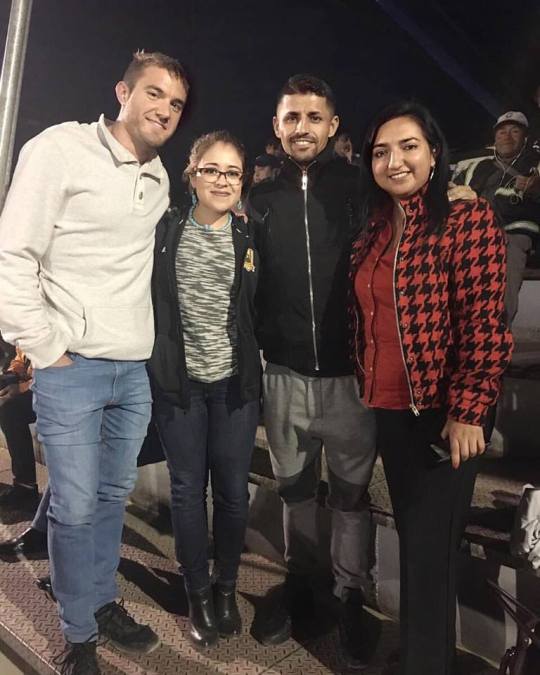
At the soccer game, with a (locally) famous player
The first weekend in January my friend Alvaro came to Xela so I could show him around since he had only visited once before for a short amount of time. Although I’ve lived here in Xela for 2 years there are still some parts I haven’t explored, so we decided to check them out together in addition to me showing him some of my favorite spots.
The following week I worked at the heath clinic in Xela as a translator for a group of medical students that came to do volunteer work. I had been to the clinic once before when I got a rabies shot, but I didn’t know all the services offered (gynecology, pediatrics, family planning, HIV testing/education, laboratory work, pharmacy, and vaccinations). Everything offered at the clinic is absolutely free for Guatemalans and foreigners that come to the clinic. While we were at the clinic I noticed a lot of people lining up for “medical cards,” which are required by almost any formal form of employment. In order to get a medical card one must give a fecal sample to prove to be free of any parasite, a blood sample to prove to be free of HIV, and a saliva sample to prove to be free of tuberculosis. I talked to one of the nurses, and she told me that often times some labs will “sell” results saying that the patient is free of one of the requirements without actually examining the sample – just another example of corruption in Guatemala. Apparently at the beginning of the year it is very common for people to start looking for jobs (as it is in the states for people to start gym memberships), which is why there were so many people lined up in the morning to get these cards.
While at the clinic my eyes were opened to some harsh truths of Guatemala – sometimes the pharmacy doesn’t have a certain medicine a patient might need and the patient doesn’t have the money to buy it in a pharmacy, therefore they settle with something that the pharmacy has that will hopefully cure the illness. The pharmacy also doesn’t usually carry combination medicines therefore doctors have to prescribe three different medicines that do the same thing as one combination medicine.
One problem that seems to be very prominent in Guatemala is diabetes. The Guatemalan diet consists of a lot of carbohydrates (rice, beans, tortillas, white sweet bread, plantains, and coffee is always sweetened), which gets converted into sugars. The medical students had a free “medical fair” in which they tested blood sugars, blood pressure, heart, lungs, and gave medical advice as needed. When checking blood sugars some people had it so high that the machine was unable to read it.
In all there were three translators, but everyone was placed at a different location. I was stationed at the health clinic and all but two of the students knew basically nothing about the Spanish language so that meant I ran around all day translating doctor’s appointments and medical advice during the medical fair. At the health clinic there are medical students at the universities here that do their residencies so they had priority over the American students (obviously because they knew the language), but I tried my best to help translate what was going on and encouraging the American students to focus on learning about the Guatemalan health system as much as they could to observe the differences. In the end I think everyone left very satisfied, and it made me realize how much more I wanted to be a Spanish translator.
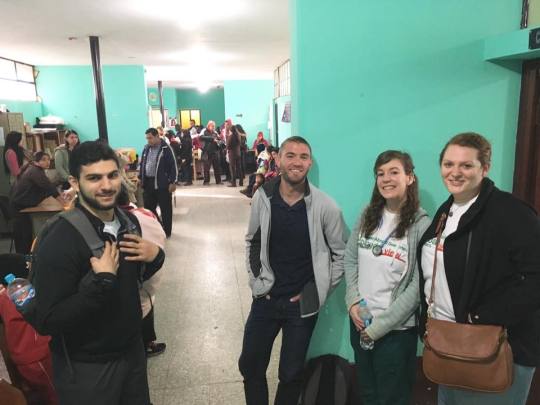

At the health clinic with some of the medical students
As soon as I was done on the last day I took the medical students to help them buy some souvenirs then met up with my best friend JJ. We grabbed a drink at a famous restaurant then went to my house to get ready for a going-away party I was invited to that night.
I met a good friend of mine from Denmark, Mia, through the Spanish school where we both studied. She comes at least once a year to visit her friends here (and actually studied for a semester abroad in Xela). That night she invited me and some other friends to have dinner together at a new restaurant in town. I had a great time because we have a ton of friends in common, so there was never a dull moment. Afterwards we all decided to go out of a bit.
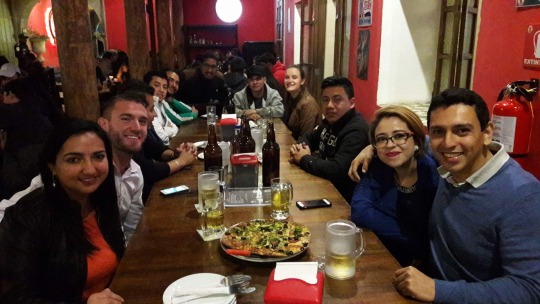
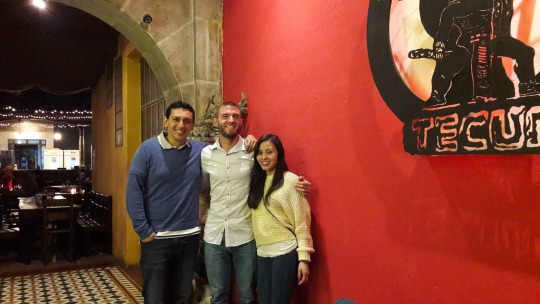
My best Guatemalan friends and me
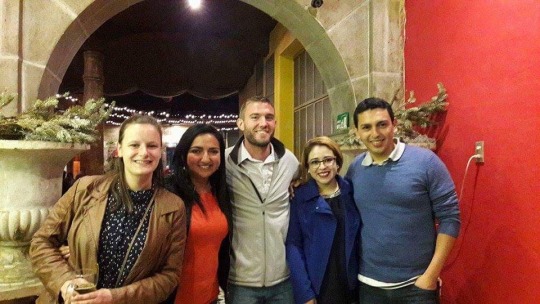
At Mia’s despedida (Mia is on the far left)
That following weekend my friend Alvaro decided to come back to Xela to visit again. This time the highlight of his stay was our trip to the Laguna Chicabal – a scared Mayan lagoon that sits on top of a volcano. One of my friends, Daniela, from Chile, decided to join us. We all met up at the central park in Xela at 8AM then went to the bus terminal. From the bus terminal to where we got off was about 40 minutes, and from there we walked 2 hours to the top of the volcano. The walk wasn’t long but it was definitely steep (and worth it!). We first went to the viewpoint of the lagoon then walked down the many stairs to the actual lagoon and ate the sandwiches we had packed that morning. Afterwards we started our hike back down but got lucky as a pickup offered us a free ride to the parking lot. We talked to the other people in the pickup, and I decided to ask someone if they were headed to Xela. When they told me they were I asked if they would be nice enough to give us a ride – to which they also replied favorably. In the end they saved us not only a bus fare, but quite a bit of time as well.

Laguna de Chicabal
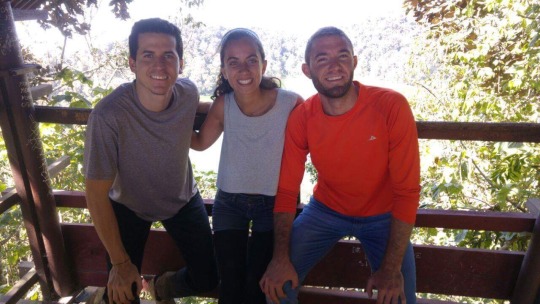
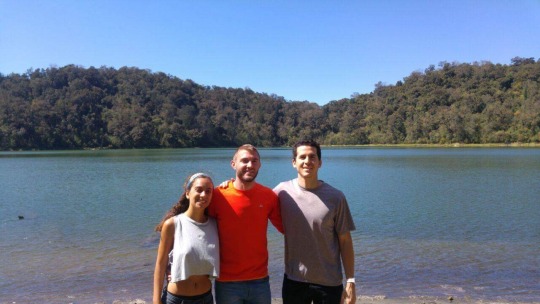
Alvaro, Daniela, and myself
After I dropped Alvaro off at the bus station to head back to Guatemala City I met up with my friend Martiza at her apartment. Her birthday is December 31, and I hadn’t properly celebrated with her so we decided to do it that night. The next day I helped her look for a new apartment because her lease was up soon and wanted to move out.
The following week was my last week in Xela so there were quite a few things I needed to do before I left. I needed to take care of things with my cell phone, the bank, packing and cleaning up my room, and some other random things to take care of before I left. I also went to visit my Guatemalan “family.” My “mom” still has students that stay with her and when I went to visit it just so happened that a student born in China decided to cook traditional Chinese food for everyone. We stayed for quite some time at the house drinking, talking, and dancing.
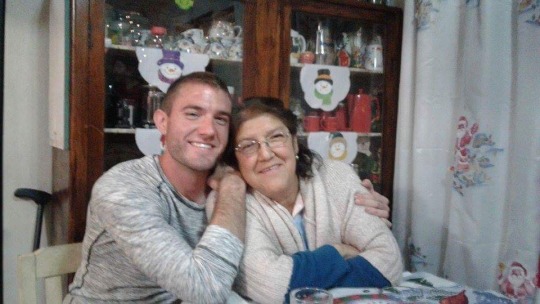
My Guatemalan Aunt Pati
On January 21 I had my despedida (going away party). I have quite a few friends and I could tell my roommates were a little worried about having a lot of people at the house so I decided to have it a bit earlier on the terrace we have that has a breath-taking view of Xela. I decided to have a little “cocktail bar,” where people could mix fresh fruit with their choice of liquor and mixer – which turned out to be a success. For me saying goodbye is always difficult, especially after forming deep relationships after having lived in Guatemala for two years. Tears and hugs were exchanged while promises were made to see each other again.
On the 22nd I headed to my Guatemalan “family’s” house for a going-away lunch with them. Before lunch was served each member of the family shared a few words with me. It didn’t take long before tears started rolling down my face. I feel extremely lucky to have had the opportunity to live with them, and the bond we share is like the bond I have with my biological family. My favorite part was exchanging random memories we all had of each other from the times I lived with them six years ago.
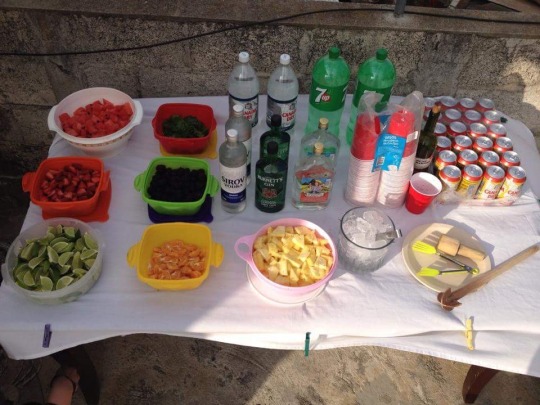
The cocktail bar buffet

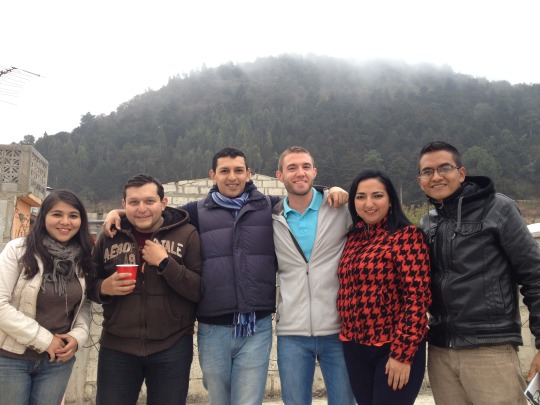
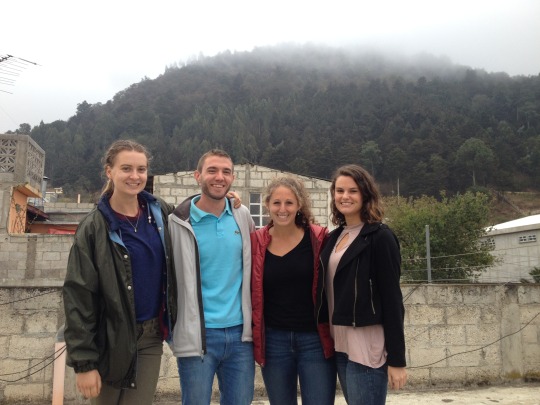
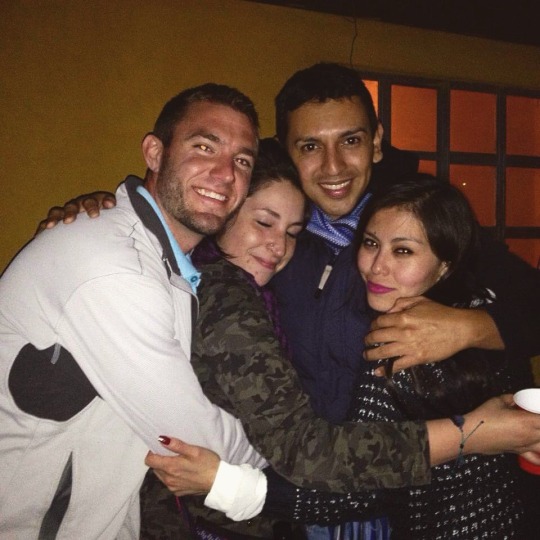
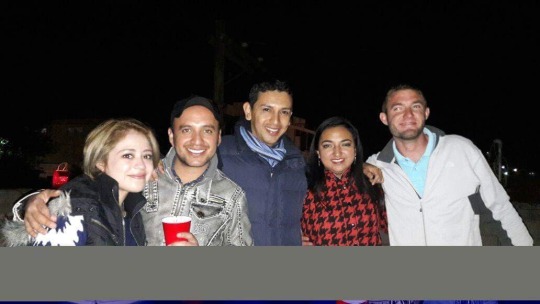
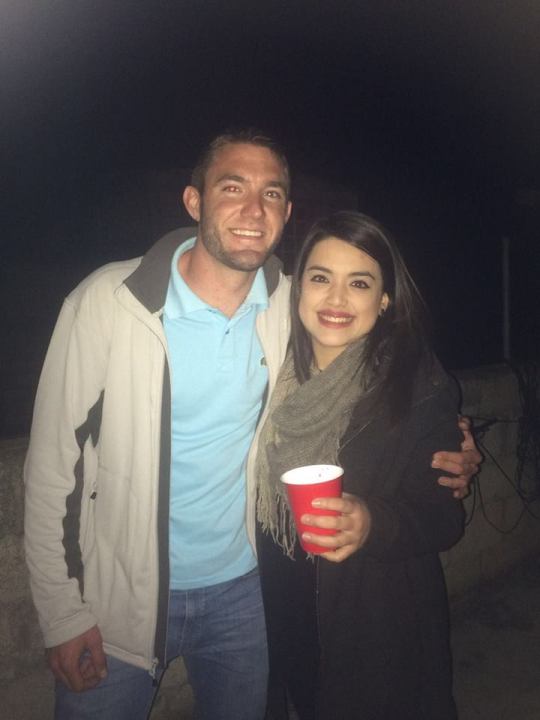

A few party pics
On the 23rd I got on a shuttle bus from Quetzaltenango to San Cristóbal, Mexico. We left roughly at 9AM and got to the border around 1PM. In all there were many shuttles shuffling tourists around so we had to wait for everybody to go through the migration control before heading off to Mexico. At about 4PM we ran into a problem – citizens of a town had blocked off a road as a form of protest. It’s pretty common in Mexico to do that to get officials’ attention, and usually works. For us it meant we either had to wait until they decided to let some cars pass or grab our stuff and walk about half a mile to the other side of the blockade. I decided to walk with some other tourists to the other side and we paid for a bus on the other side to take us to San Cristóbal. That night I was pretty tired, so I just checked into my AirBnB, ate dinner, then went to bed.

The blockade
The next day I literally spent the whole time walking around the city. San Cristóbal is very touristy because of the pretty colonial architecture and churches. I found a pretty neat museum called Na Bolom, which was an old catholic seminary that later became the house of a Danish archaeologist, Frans Blom, and his Swiss wife, Gertrude Duby. In the museum part they displayed the work they had done to preserve the culture and art of the indigenous people living in the Lacandona forest (located in the same region). I enjoyed my time there (most of all the Mexican food), but knew that after a day I had seen most of what I wanted to see within the city limits. That night I got on an overnight bus to take the 12 hours bus ride to Oaxaca.
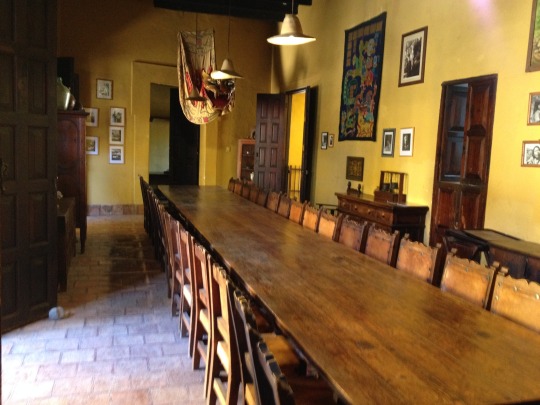
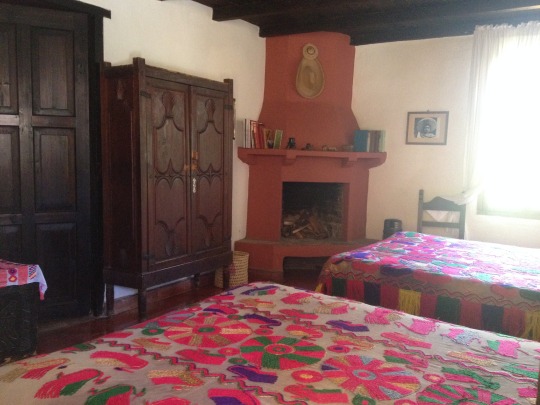
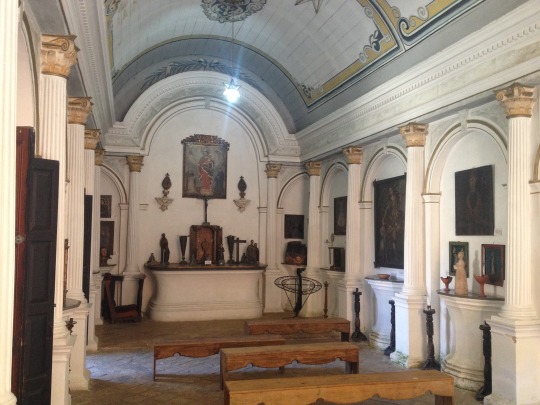
At the Na Bolom museum
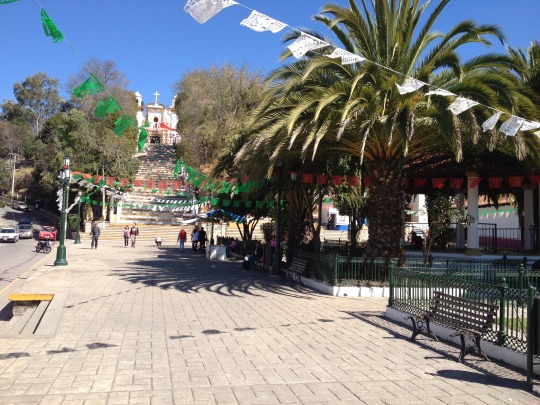
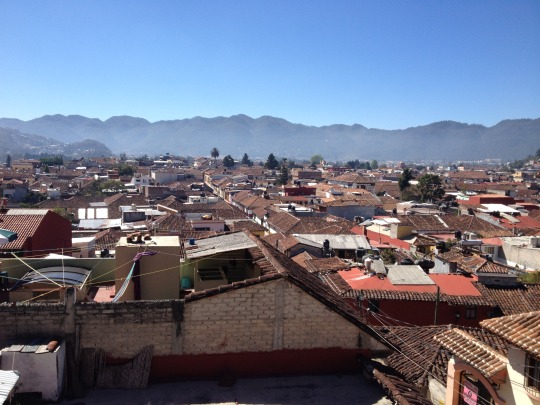
San Cristóbal
I got to Oaxaca at 7AM on the 18th and immediately dropped off my bags at the bus station then walked around the city. I got breakfast in one of the largest plazas – two tamales and Mexican hot chocolate (one of the best breakfasts ever!). It was awesome to literally watch the city wake up as I wondered around the town. Around 1PM I met up with who I would be staying with the next two days – a woman named Maru, her husband, and a family friend that helped drive them around.
Years ago my mom visited a winery in Kansas and became instant friends with the owner, a Mexican woman. When my mom heard I would be moving to Mexico she called her and it turns out her sister had a house in Oaxaca. I got everything worked out, and they hosted me for the two days I stayed there without having met me prior to my arrival. Although they were a bit older I really, really enjoyed my time with them – they were extremely nice people and wanted to show me as much as possible. As soon as we met up they took me to their house to drop off my stuff then we went to some Zapotec ruins at a place called Mitla. Mitla (or Michtlan) means “place of rest/dead” in the Zapotec language. The first evidence of human occupation was in 0-200AD, but it reached its highest point around 950-1521AD. After the Spanish arrived in the area a Catholic temple was built over one of the patios using destroyed prehispanic structures. Basically instead of destroying the ruins at Mitla the Spanish decided to build a Catholic church right next to it. Afterwards we grabbed a nieve (literally snow), which is famous in Oaxaca. The best way I can describe it is as a natural fruit sorbet (and delicious). We then headed to a town called Tule, which is famous for a tree that is over 2,000 years old. It was so large that I couldn’t get it all in a photo. One thing that was neat was that they have little kids that are “guides” that will point out all the animals that can be found in the bark of the tree (dolphins, lions, snakes to name a few). We then went to a market and ate tlayuda, which is basically a Mexican pizza (tortilla crust, refried beans, a type of cheese typical to the region, meat of your choice, avocado, and tomato). On the way back to Oaxaca we stopped at a “scenic view” of the city to watch the sunset. Oaxaca reminds me a lot of Arizona, a state with a beautiful landscape. We then went back to their house, watched a Spanish soap opera, and had chiles rellenos for dinner.
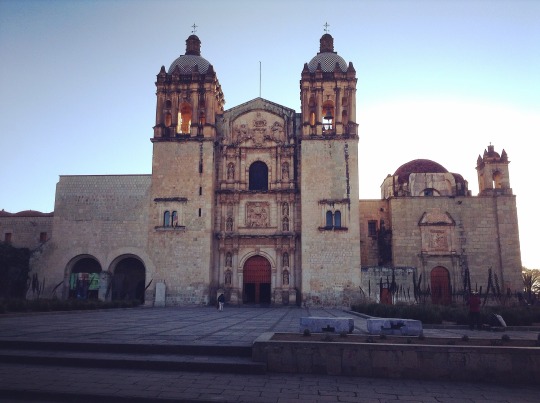

In Oaxaca

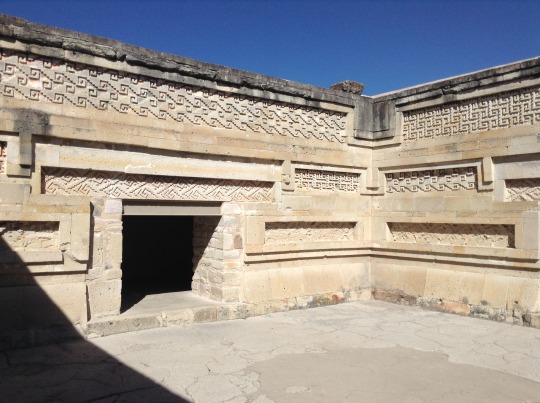
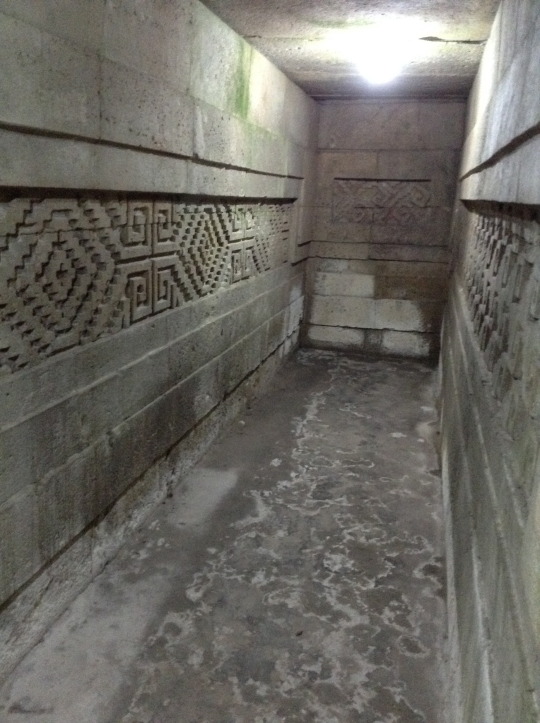
Inside one of the tombs
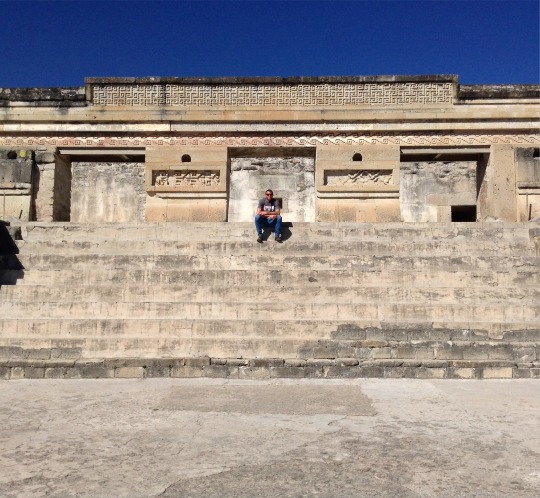
Mitla Ruins
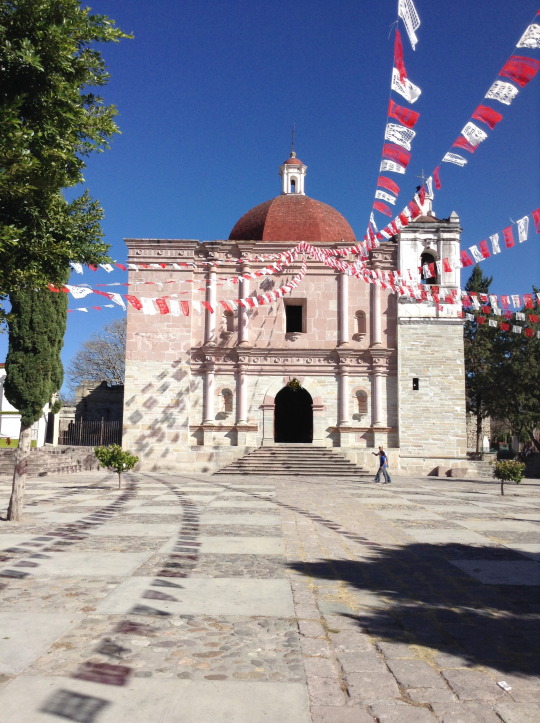
The Catholic Church next to the ruins at Mitla

The tlayuda

The 2,000+ year old tree in Tule
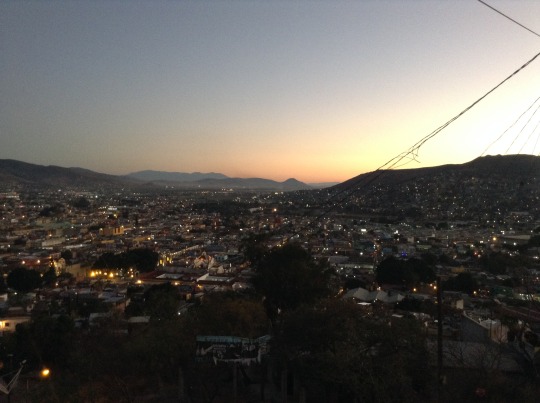
Sunset over Oaxaca
The next day their “chofer” took me to a place called Hirve el Agua (boil the water), which is famous for its petrified waterfalls. What causes them is the water that comes out of the earth (it looks like it’s boiling – hence the name) that has a very high mineral composition. Since it’s only a small amount of water that comes out of the earth it forms the petrified waterfalls as it falls down the cliff. When we got there the first thing I saw was absolutely amazing – nature’s infinity pool. The highly mineralized water first collects in a pool then runs over into the petrified waterfalls, which meant the “infinity pool” was at the top of the petrified waterfalls, in the middle of a jaw-dropping Mexican landscape. Despite the name, the water was actually a bit chilly. After I took a dip we walked to the bottom of the waterfalls then back up them again. I took another dip in the pool then we decided to head back to the house.
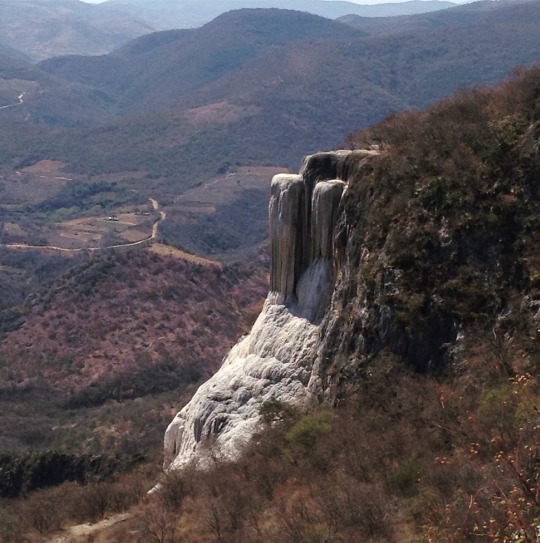
The petrified waterfall
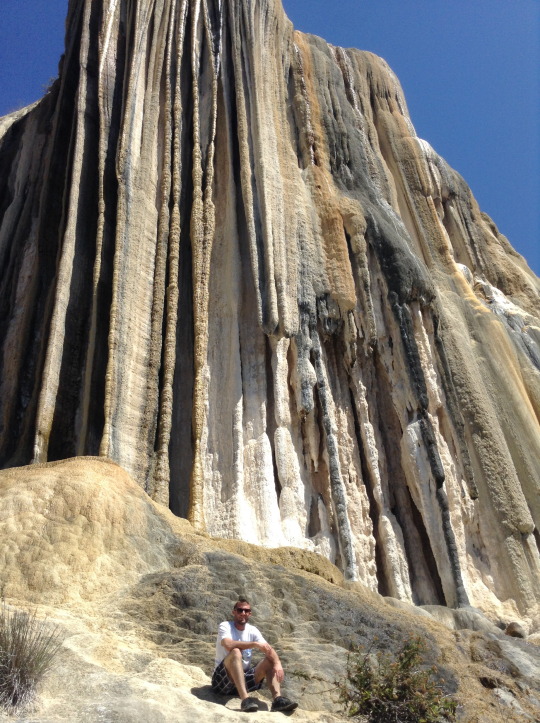
At the bottom
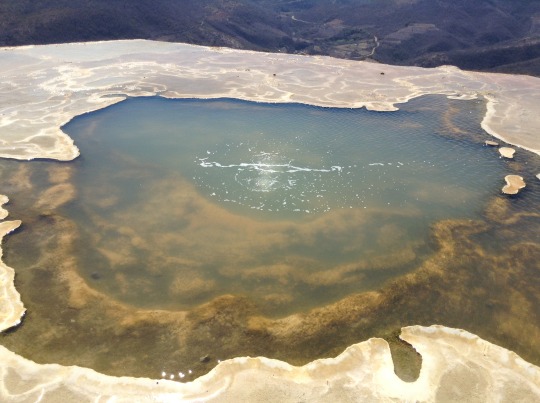
Where the water comes out of the earth (in a “boiling” fashion)
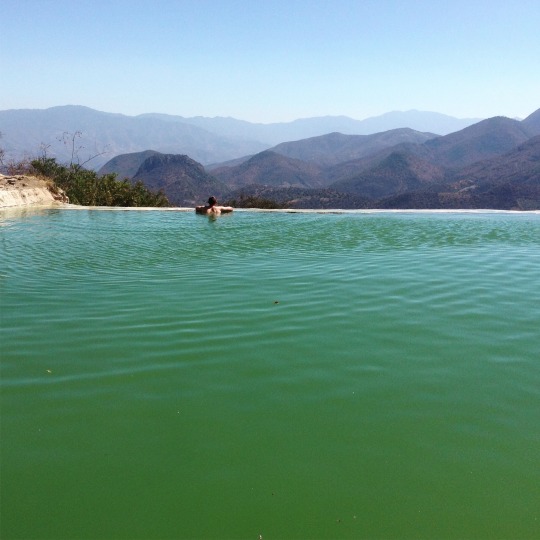
Nature’s infinity pool
Lunch was waiting for us when we arrived – carne asada, rice, and a salad. Afterwards we hung out at the house for a while then we all decided to go for a car ride around the countryside. We stopped at a little roadside stand where a traditional chocolate drink called tascalate made from corn, chocolate, sugar, and cinnamon with natural cream that floats on the top. It’s also called agua de los dioses (water of the gods). They also had a sweet drink made from a type of pumpkin and a bread that they soak in vinegar and top with onion and chili for sale, but the tascalate was my favorite. We then headed back to the house to watch Mexican soap operas and have dinner.
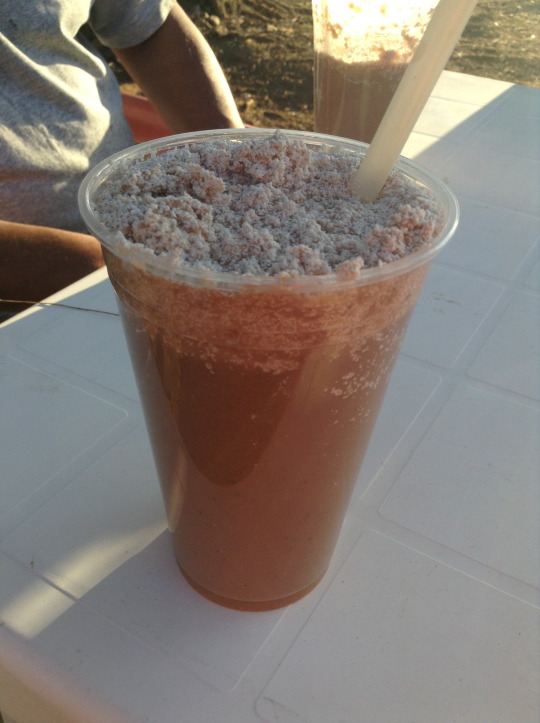
The tascalate
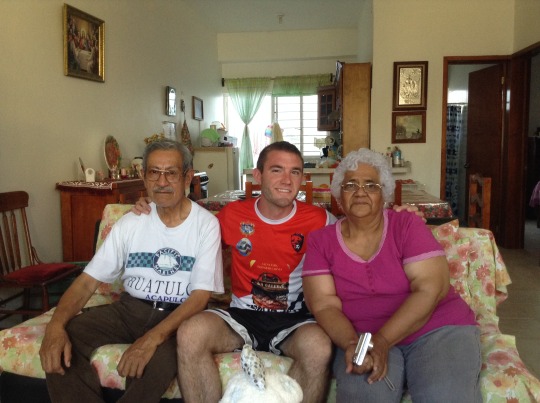
January 27th will be a day I will probably never forget – as I boarded the bus in Oaxaca, Mexico, I knew I was turning the last page in the Guatemalan chapter of my life story. Just like watching the season final of your favorite television series I anxiously sat in the bus thinking about my future – what I would experience, learn, how I would help others, and how I would continue growing as a person.
Good feelings.
1 note
·
View note
Text
China Silences Critics Over Coronavirus Outbreak
The SARS disaster was supposed to drag China into a new era of openness and responsibility. The deadly disease rippled across the world 17 years ago, abetted by a Chinese government that covered up its spread. As the scope of it became clear, China’s journalists, intellectuals and other critics helped shame Beijing into opening up about the problem.
“SARS has been our country’s 9/11,” said Xu Zhiyuan, then a young newspaper columnist and a fierce critic of the government’s handling of SARS, in a 2003 interview with The New York Times. “It has forced us to pay attention to the real meaning of globalization.”
Today, China faces the spread of another mysterious disease, a coronavirus, which so far has killed 17 people and infected more than 570. And while Beijing’s response has improved in some ways, it has regressed in others. It is censoring criticism. It is detaining people for spreading what it calls “rumors.” It is suppressing information it deems alarming.
Though China’s censors are busily scrubbing the Chinese internet, the country’s online community is registering its disappointment and alarm over Beijing’s handling of the new virus that has spread since December from the city of Wuhan to other countries, even the United States.
“I thought SARS would force China to rethink its governance model,” Mr. Xu, now a video talk show host, wrote on social media on Tuesday, also posting a screenshot of his 2003 quote in The Times. “I was too naïve.”
In many ways, China has changed for the better since the SARS epidemic. Its economy has grown eightfold. It has built more skyscrapers, subways and high-speed rail lines than any other country. Its tech companies rival Silicon Valley’s giants. A more responsive bureaucracy provides more people with health care, social services and even quality-of-life improvements like parks.
When it comes to handling diseases, the public health system has greatly improved. Wuhan, the epicenter of the outbreak, is also home to one of the most advanced epidemic disease research laboratories in the world.
Those improvements have come at a price. The government has tightened its grip on the internet, the media and civil society. It has deeper pockets and a greater ability to control the flow of information across the country.
As a result, many of the media outlets, advocacy groups, activists and others who held the government accountable in 2003 have been silenced or sidelined.
“The system is successful in that it destroyed the people with integrity, the institutions with credibility and a society capable of narrating its own stories,” Mr. Xu said on social media. “What’s left is an arrogant power, a bunch of messy information and many fragile, isolated and angry individuals.”
Even as the new virus spread through Wuhan, the government took pains to keep up appearances.
The first case was reported Dec. 8. As the disease spread, Wuhan officials insisted that it was controlled and treatable. The police questioned eight people who posted on social media about the virus, saying they had spread “rumors.”
On Saturday, two days before Wuhan told the world about the severity of the outbreak, it hosted a potluck banquet attended by more than 40,000 families so the city could apply for a world record for most dishes served at an event. On the day it broke the news to the world, it also announced that it was distributing 200,000 free tickets to residents for festival activities during the Lunar New Year holiday, which begins this Saturday.
The central government backed Wuhan’s officials. Wang Guangfa, a prominent government respiratory expert, told the state broadcaster China Central Television on Jan. 10 that the Wuhan pneumonia was “under control” and mostly a “mild condition.” Eleven days later, he confirmed to Chinese media that he might have contracted the virus himself during an inspection in Wuhan.
Recognizing an outbreak can take time, and China is not the first government caught flat footed by a disease.
But the choices made by government officials had an impact on a major commercial and transportation hub. Wuhan is a city of 11 million people, including nearly one million college students from across the country. By the time it disclosed the seriousness of the outbreak, the 40-day Lunar New Year travel season, when Chinese people take an estimated three billion trips combined, had already begun.
People might have made different decisions had websites and headlines described growing worries. Instead, they traveled. On Tuesday, all five confirmed cases in Beijing were people who had traveled to Wuhan in January for business, study or leisure.
Until a week ago, some people in China called it the “patriotic virus.” Cases appeared in Hong Kong, Thailand, Vietnam, Japan and elsewhere in Asia. No other Chinese city but Wuhan reported infection cases. It was not until the Hong Kong news media reported over the weekend that the virus had been found in other cities did officials elsewhere come forward.
Some critics see parallels to SARS. In 2003, the Guangzhou newspaper Southern Metropolis Daily first reported the SARS outbreak. A military doctor, Jiang Yanyong, came forward with what he knew. Only then did officials act.
“The way this virus came into the public view is the same as that of SARS 17 years ago,” said Rose Luqiu, an assistant journalism professor who covered SARS as a reporter for the Hong Kong-based Phoenix Television.
Many of those brave voices in 2003 are gone. Like almost all Chinese media outlets that were active in the 1990s and 2000s, the Southern Metropolis Daily has lost its freedom to pursue coverage that holds local governments, if not Beijing, accountable. Only a few mainland news media outlets are covering the current crisis critically, and then only with an analytical tone.
In 2003, Phoenix Television called Ms. Luqiu, then a star reporter, back from Iraq to report on SARS in Beijing. She shadowed the newly appointed Beijing mayor, Wang Qishan, for a week to cover how the government dealt with the crisis. Mr. Wang later became the vice president of China.
That kind of openness is unimaginable now. Last week, when a group of Hong Kong journalists went to the Wuhan hospital that took in most coronavirus patients, the police detained them for a few hours. They were asked to delete their TV footage and hand in their phones and cameras for inspection.
On Tuesday, Ms. Luqiu wrote an article for qq.com, the news site owned by the internet giant Tencent, about the measures the Hong Kong government has taken in dealing with the virus. The article was deleted 10 hours later.
Dr. Jiang, the military doctor who became a whistle-blower in 2003, has been put under periodic house arrest and forbidden to visit the United States to collect a human rights award. He is also portrayed as a bad role model. A multiple-choice question posed by a test-prep school in 2017 asked about Dr. Jiang’s decision. The correct answer was B: It was wrong because it harmed the interests of the nation, the society and the community and should be subject to legal punishment.
China’s disclosures have improved in many ways since SARS. The government admitted the problem faster. Beijing officials have shown determination to be more transparent. A top party committee said on Tuesday that it would not tolerate any efforts to hide infections.
“Whoever deliberately delays or conceals reporting for the sake of their own interests will be forever nailed to history’s pillar of shame,” the committee said in a post on WeChat. The post was later deleted.
But when the government is the only source of information, wise advice and valuable clues can be lost. A police bureau in eastern Shandong Province posted on the Twitter-like social media platform Weibo on Wednesday that it had detained four residents who spread rumors that there was a suspected coronavirus patient in the district. In that environment, others dare not speak out.
“The authorities are sending a signal, which is that only the government agencies can talk about the epidemic,” Yu Ping, a former Southern Metropolis Daily reporter, wrote on his personal blog. “All other people should just shut up.”
“It’s not public disclosure,” Mr. Yu added. “It’s a naked information monopoly.”
from WordPress https://mastcomm.com/event/china-silences-critics-over-coronavirus-outbreak-2/
0 notes
Text
China Silences Critics Over Coronavirus Outbreak
The SARS disaster was supposed to drag China into a new era of openness and responsibility. The deadly disease rippled across the world 17 years ago, abetted by a Chinese government that covered up its spread. As the scope of it became clear, China’s journalists, intellectuals and other critics helped shame Beijing into opening up about the problem.
“SARS has been our country’s 9/11,” said Xu Zhiyuan, then a young newspaper columnist and a fierce critic of the government’s handling of SARS, in a 2003 interview with The New York Times. “It has forced us to pay attention to the real meaning of globalization.”
Today, China faces the spread of another mysterious disease, a coronavirus, which so far has killed 17 people and infected more than 570. And while Beijing’s response has improved in some ways, it has regressed in others. It is censoring criticism. It is detaining people for spreading what it calls “rumors.” It is suppressing information it deems alarming.
Though China’s censors are busily scrubbing the Chinese internet, the country’s online community is registering its disappointment and alarm over Beijing’s handling of the new virus that has spread since December from the city of Wuhan to other countries, even the United States.
“I thought SARS would force China to rethink its governance model,” Mr. Xu, now a video talk show host, wrote on social media on Tuesday, also posting a screenshot of his 2003 quote in The Times. “I was too naïve.”
In many ways, China has changed for the better since the SARS epidemic. Its economy has grown eightfold. It has built more skyscrapers, subways and high-speed rail lines than any other country. Its tech companies rival Silicon Valley’s giants. A more responsive bureaucracy provides more people with health care, social services and even quality-of-life improvements like parks.
When it comes to handling diseases, the public health system has greatly improved. Wuhan, the epicenter of the outbreak, is also home to one of the most advanced epidemic disease research laboratories in the world.
Those improvements have come at a price. The government has tightened its grip on the internet, the media and civil society. It has deeper pockets and a greater ability to control the flow of information across the country.
As a result, many of the media outlets, advocacy groups, activists and others who held the government accountable in 2003 have been silenced or sidelined.
“The system is successful in that it destroyed the people with integrity, the institutions with credibility and a society capable of narrating its own stories,” Mr. Xu said on social media. “What’s left is an arrogant power, a bunch of messy information and many fragile, isolated and angry individuals.”
Even as the new virus spread through Wuhan, the government took pains to keep up appearances.
The first case was reported Dec. 8. As the disease spread, Wuhan officials insisted that it was controlled and treatable. The police questioned eight people who posted on social media about the virus, saying they had spread “rumors.”
On Saturday, two days before Wuhan told the world about the severity of the outbreak, it hosted a potluck banquet attended by more than 40,000 families so the city could apply for a world record for most dishes served at an event. On the day it broke the news to the world, it also announced that it was distributing 200,000 free tickets to residents for festival activities during the Lunar New Year holiday, which begins this Saturday.
The central government backed Wuhan’s officials. Wang Guangfa, a prominent government respiratory expert, told the state broadcaster China Central Television on Jan. 10 that the Wuhan pneumonia was “under control” and mostly a “mild condition.” Eleven days later, he confirmed to Chinese media that he might have contracted the virus himself during an inspection in Wuhan.
Recognizing an outbreak can take time, and China is not the first government caught flat footed by a disease.
But the choices made by government officials had an impact on a major commercial and transportation hub. Wuhan is a city of 11 million people, including nearly one million college students from across the country. By the time it disclosed the seriousness of the outbreak, the 40-day Lunar New Year travel season, when Chinese people take an estimated three billion trips combined, had already begun.
People might have made different decisions had websites and headlines described growing worries. Instead, they traveled. On Tuesday, all five confirmed cases in Beijing were people who had traveled to Wuhan in January for business, study or leisure.
Until a week ago, some people in China called it the “patriotic virus.” Cases appeared in Hong Kong, Thailand, Vietnam, Japan and elsewhere in Asia. No other Chinese city but Wuhan reported infection cases. It was not until the Hong Kong news media reported over the weekend that the virus had been found in other cities did officials elsewhere come forward.
Some critics see parallels to SARS. In 2003, the Guangzhou newspaper Southern Metropolis Daily first reported the SARS outbreak. A military doctor, Jiang Yanyong, came forward with what he knew. Only then did officials act.
“The way this virus came into the public view is the same as that of SARS 17 years ago,” said Rose Luqiu, an assistant journalism professor who covered SARS as a reporter for the Hong Kong-based Phoenix Television.
Many of those brave voices in 2003 are gone. Like almost all Chinese media outlets that were active in the 1990s and 2000s, the Southern Metropolis Daily has lost its freedom to pursue coverage that holds local governments, if not Beijing, accountable. Only a few mainland news media outlets are covering the current crisis critically, and then only with an analytical tone.
In 2003, Phoenix Television called Ms. Luqiu, then a star reporter, back from Iraq to report on SARS in Beijing. She shadowed the newly appointed Beijing mayor, Wang Qishan, for a week to cover how the government dealt with the crisis. Mr. Wang later became the vice president of China.
That kind of openness is unimaginable now. Last week, when a group of Hong Kong journalists went to the Wuhan hospital that took in most coronavirus patients, the police detained them for a few hours. They were asked to delete their TV footage and hand in their phones and cameras for inspection.
On Tuesday, Ms. Luqiu wrote an article for qq.com, the news site owned by the internet giant Tencent, about the measures the Hong Kong government has taken in dealing with the virus. The article was deleted 10 hours later.
Dr. Jiang, the military doctor who became a whistle-blower in 2003, has been put under periodic house arrest and forbidden to visit the United States to collect a human rights award. He is also portrayed as a bad role model. A multiple-choice question posed by a test-prep school in 2017 asked about Dr. Jiang’s decision. The correct answer was B: It was wrong because it harmed the interests of the nation, the society and the community and should be subject to legal punishment.
China’s disclosures have improved in many ways since SARS. The government admitted the problem faster. Beijing officials have shown determination to be more transparent. A top party committee said on Tuesday that it would not tolerate any efforts to hide infections.
“Whoever deliberately delays or conceals reporting for the sake of their own interests will be forever nailed to history’s pillar of shame,” the committee said in a post on WeChat. The post was later deleted.
But when the government is the only source of information, wise advice and valuable clues can be lost. A police bureau in eastern Shandong Province posted on the Twitter-like social media platform Weibo on Wednesday that it had detained four residents who spread rumors that there was a suspected coronavirus patient in the district. In that environment, others dare not speak out.
“The authorities are sending a signal, which is that only the government agencies can talk about the epidemic,” Yu Ping, a former Southern Metropolis Daily reporter, wrote on his personal blog. “All other people should just shut up.”
“It’s not public disclosure,” Mr. Yu added. “It’s a naked information monopoly.”
Sahred From Source link Health
from WordPress http://bit.ly/2TP6aqh via IFTTT
0 notes
Text
China Silences Critics Over Coronavirus Outbreak
The SARS disaster was supposed to drag China into a new era of openness and responsibility. The deadly disease rippled across the world 17 years ago, abetted by a Chinese government that covered up its spread. As the scope of it became clear, China’s journalists, intellectuals and other critics helped shame Beijing into opening up about the problem.
“SARS has been our country’s 9/11,” said Xu Zhiyuan, then a young newspaper columnist and a fierce critic of the government’s handling of SARS, in a 2003 interview with The New York Times. “It has forced us to pay attention to the real meaning of globalization.”
Today, China faces the spread of another mysterious disease, a coronavirus, which so far has killed 17 people and infected more than 540. And while Beijing’s response has improved in some ways, it has regressed in others. It is censoring criticism. It is detaining people for spreading what it calls “rumors.” It is suppressing information it deems alarming.
Though China’s censors are busily scrubbing the Chinese internet, the country’s online community is registering its disappointment and alarm over Beijing’s handling of the new virus that has spread since December from the city of Wuhan to other countries, even the United States.
“I thought SARS would force China to rethink its governance model,” wrote Mr. Xu, now a video talk show host, on social media on Tuesday, who also posted a screenshot of his 2003 quote in the Times. “I was too naïve.”
In many ways, China has changed for the better since the SARS epidemic. Its economy has grown eightfold. It has built more skyscrapers, subways and high-speed rail lines than any other country. Its tech companies rival Silicon Valley’s giants. A more responsive bureaucracy provides more people with health care, social services and even quality of life improvements like parks.
When it comes to handling diseases, the public health system has improved dramatically. Wuhan, the epicenter of the outbreak, is also home to one of the most advanced epidemic disease research laboratories in the world.
Those improvements have come at a price. The government has tightened its grip on the internet, the media and civil society. It has deeper pockets and a greater ability to control the flow of information across the country.
As a result, many of the media outlets, advocacy groups, activists and others who held the government accountable in 2003 have been silenced or sidelined.
“The system is successful in that it destroyed the people with integrity, the institutions with credibility and a society capable of narrating its own stories,” Mr. Xu said on social media. “What’s left is an arrogant power, a bunch of messy information and many fragile, isolated and angry individuals.”
Even as the new virus spread through Wuhan, the government took pains to keep up appearances.
The first case was reported Dec. 8. As the disease spread, Wuhan officials insisted it was controlled and treatable. Police questioned eight people who posted on social media about the virus, saying that they had spread “rumors.”
On Jan. 18, two days before Wuhan told the world about the severity of the outbreak, it hosted a potluck banquet attended by more than 40,000 families so the city could apply for a world record for most dishes served at an event. On the day it broke the news to the world, it also announced that it was distributing 200,000 free tickets to local residents for attending festival activities during the Lunar New Year holiday, which begins on Saturday.
The central government backed Wuhan’s officials. Wang Guangfa, a prominent government respiratory expert, told the state broadcaster China Central Television on Jan. 10 that the Wuhan pneumonia was “under control” and mostly a “mild condition.” Eleven days later, he confirmed to Chinese media that he might have contracted the virus himself during an inspection in Wuhan.
Recognizing an outbreak can take time, and China is not the first government caught flat-footed by a disease.
But the choices made by government officials impacted a major commercial and transportation hub. Wuhan is a city of 11 million people, including nearly one million college students from across the country. By the time it disclosed the seriousness of the outbreak, the Lunar New Year travel season had already begun, a 40-day period during which Chinese people take an estimated three billion trips combined.
People might have made different decisions had websites and headlines described growing worries. Instead, they traveled. On Tuesday, all five confirmed cases in Beijing were of people who traveled to Wuhan in January for business, study or leisure.
Until a week ago, some people in China called it the “patriotic virus.” Cases appeared in Hong Kong, Thailand, Vietnam, Japan and elsewhere in Asia. No other Chinese city but Wuhan reported infection cases. It was not until the Hong Kong news media reported over the weekend that the virus had been found in other cities did officials elsewhere come forward.
Some critics see parallels to SARS. In 2003, the Guangzhou-based newspaper Southern Metropolis Daily first reported the SARS outbreak. A military doctor named Jiang Yanyong came forward with what he knew. Only then did officials act.
“The way this virus came into the public view is the same as that of SARS 17 years ago,” said Rose Luqiu, an assistant journalism professor who covered SARS as a reporter for the Hong Kong-based Phoenix Television.
Many of those brave voices in 2003 are gone. Like almost all Chinese media outlets that were active in the 1990s and 2000s, the Southern Metropolis Daily has lost its freedom to pursue coverage that holds local governments, if not Beijing, accountable. Only a few mainland news media outlets are covering the current crisis critically, and then only with an analytical tone.
In 2003, Phoenix Television called Ms. Luqiu, then a star reporter, back from Iraq to report on SARS in Beijing. She shadowed the newly appointed Beijing mayor, Wang Qishan, for a week to cover how the government dealt with the crisis. Mr. Wang later became the vice president of China.
That kind of openness is unimaginable now. Last week, when a group of Hong Kong journalists went to the Wuhan hospital that took in most coronavirus patients, they were detained by police for a few hours. They were asked to delete their TV footage and hand in their phones and cameras for inspection.
On Tuesday, Ms. Luqiu wrote an article for qq.com, the news site owned by the internet giant Tencent, about the measures the Hong Kong government has taken in dealing with the virus. The article was deleted 10 hours later.
As for Dr. Jiang, the military doctor who became a whistle-blower in 2003, he has been put under periodic house arrest and forbidden to visit the United States to collect a human rights award. He is also portrayed as a bad role model. A multiple-choice question posed by a test-prep school in 2017 asked about Mr. Jiang’s decision. The correct answer was B: It was wrong because it harmed the interests of the nation, the society and the community and should be subject for legal punishment.
China’s disclosures have improved in many ways since SARS. The government admitted the problem faster. Beijing officials have shown determination to be more transparent. A top party committee on Tuesday said that it would not tolerate any efforts to hide infections.
“Whoever deliberately delays or conceals reporting for the sake of their own interests will be forever nailed to history’s pillar of shame,” the committee said in a post on WeChat. The post was later deleted.
But when the government is the only source of information, wise advice and valuable clues can be lost. A local police bureau in eastern Shandong province posted on the Twitter-like social media platform Weibo on Wednesday that it had detained four local residents who spread rumors that there was a suspected coronavirus patient in the district. In that environment, others dare not speak out.
“The authorities are sending a signal, which is that only the government agencies can talk about the epidemic,” Yu Ping, a former Southern Metropolis Daily reporter, wrote on his personal blog. “All other people should just shut up.”
“It’s not public disclosure,” Mr. Yu added. “It’s a naked information monopoly.”
from WordPress https://mastcomm.com/business/china-silences-critics-over-coronavirus-outbreak/
0 notes